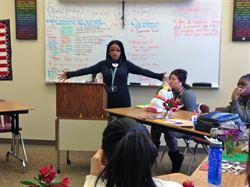World History

-
World History: 9th Grade
Syllabus
Instructor: Ms. Glaspie
1037 University Avenue West
St. Paul, Minnesota 55104
Email: jolene.glaspie@spps.org
Office Hours: 3:00-4:00 daily in room 1040
Course Length: One Year (Two Quarters)
Course Description:
Welcome to 9th grade World History. This one year course examines the patterns of human behavior using a thematic approach as a way to help us make sense of how people and societies have evolved over time. Often, historians use themes to understand how people developed cultural and societal ways of being. We’ll learn about the political and economic structures societies developed to advance their civilizations. And finally, we will also look at how people of the past interacted with their environments, which offers us clues for why they made the decisions that benefited them most. Taking this approach to the study of world history allows us to have a “big-picture” of the diversity of major events that contributed to whom we are today. My hope is that you’ll enjoy the journey we take around the world as we explore how and why things came to be.
Essential Content Questions Explored in the Course by Quarter:
Quarters 1 & 3
*How can world history be described using recurring themes?
*How did environmental factors cause early human migration out of Africa?
*How did farming change the way humans lived in prehistory?
*What are the characteristics of a civilization?
*What causes a civilization to decline?
*How did religion and philosophy influence a civilization's development?
*What impact did the rise and expansion of Islam have on other regions?
*How did belief systems influence China and Japan between 600 and 1450?
*How did Christianity influence Eastern and Western Europe between 600-1450?
*What were the results of increased interactions between Christians and Muslims during 60-1450?
*What were the characteristics of Ancient African kingdoms?
*How did Indian Ocean trade impact the cultures of South and Southeast Asia?
Quarters 2 & 4
*What changes were happening in Europe between 1450-1750 that led to exploration and colonization?
*What were the results of the expansion of the Ottoman Empire?
*What was the impact of interaction between Indigenous peoples and Europeans?
What were the causes, forms, and consequences of slavery found within African, European and Arab societies?
What are the causes and factors of revolutions and rebellions?
What are the effects and impact of revolutions and rebellions?
What were the consequences and responses to European and American imperialism?
How did the expansion chattel slavery and its abolition affect pepes and regions?
What were the causes and consequence of World War I?
What were the factors that led to the rise of fascist and nationalist dictators in Europe and Asia?
What were the turning points and their consequences of WWII?
What were the causes and consequences of the Holocaust?
What was the Cold War?
How did the Cold War affect the balance of power after World War II?
How did the concept of human rights develop during the Cold War?
What are the effects of globalization of trade on developing and developed countries (economical, technological and political)?
Course Requirements:
*Students are expected to complete all assigned readings, use the AVID learning strategies taught and participate in class discussions and other engaging exercises. Students also need to complete quizzes, test, essays and assignments.
*World History Journal (Keep all lessons for the course in the self-created notebook)
*Schoology (Check Schoology daily as a way to know what lessons are assigned and to keep up with the grade you’re striving to earn.)
*Use the textbook, “History Alive” and various articles assigned as a means to answer the essential questions.
*Give presentations.
*Help to create and be a part of an atmosphere that promotes positivity and support for self and others in the course.
Student Evaluation & Assessments
“A” 90-100% (Student earns high tests scores, turns in all essays, completes all journal lessons, participates in class discussions, gives presentations, misses less than 3 days in the course.)
“B” 80-89% (Student earns high tests scores, turns in all essays, completes all journal lessons participates in class discussions, gives presentations, misses less than 5 days in the course.)
“C” 70-79% (Student tries to complete all or most of the lessons in the course and misses less than 9 days in the course.)
“D”60-69% (Student misses assignments and days of school, but takes all quizzes and completes all essays assigned.)
“D-” 50-59% (Student misses many lessons taught, but still takes quizzes missed due to multiple days missed in the course.)
“N”-0-49% (Very little lessons completed, nor effort put into the course, and misses far too many days of school to pass.)
All tasks completed in the course are used to create a formative and summative assessment grade that will be accumulated at the end of the course to show how many points earned. The final grade will be determined by the amount of points earned for all lessons completed.
Late Work: I will accept late work, but points will be reduced (usually 5-10 points for everyday the lesson is not done for up to two weeks.). If turned in three weeks late, the grade for the lesson will be reduced by 50% automatically.
Essays: All essays should be written using the guiding prompt questions provided for the lesson. Also, use MLA double spaced, 12 point Times New Roman). You must complete these essays to pass the course. Rough drafts will need to be completed in your journals for the class.






